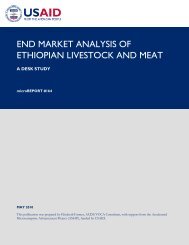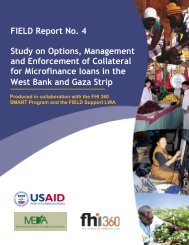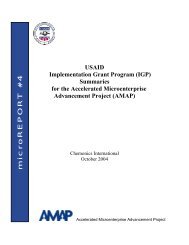Madagascar Aromatic and Medicinal Plants Value - Microlinks
Madagascar Aromatic and Medicinal Plants Value - Microlinks
Madagascar Aromatic and Medicinal Plants Value - Microlinks
Create successful ePaper yourself
Turn your PDF publications into a flip-book with our unique Google optimized e-Paper software.
1. EXPORT MARKETS<br />
In terms of value, it is estimated that 80-90 percent of <strong>Madagascar</strong>’s AMP products are intended for export, the<br />
majority of which are essential oils. Exports totaled $4 million in 2004. There is growing dem<strong>and</strong> (8-15 percent per<br />
year) 3 for many popular species of medicinal plants in Europe, North America <strong>and</strong> Asia. Factors <strong>and</strong> market trends<br />
that will potentially increase the dem<strong>and</strong> for medicinal plants are:<br />
• increased costs of institutional <strong>and</strong> pharmaceutical-based health care<br />
• search for new drugs <strong>and</strong> treatments of serious diseases<br />
• consumers seeking an alternative or complement to pharmaceutical drugs <strong>and</strong> modern healthcare<br />
• large pharmaceutical <strong>and</strong> over-the-counter companies placing botanical medicines more strongly on the mass<br />
market through increased advertising budgets <strong>and</strong> media attention<br />
• increased emphasis on safety, efficacy <strong>and</strong> quality that could push producers in <strong>Madagascar</strong> to increase research<br />
<strong>and</strong> development, thereby improving the quality of medicinal products to conform to international st<strong>and</strong>ards<br />
• increased requests for organically certified raw material or value-added products, especially for the development<br />
of new products (e.g., medicines, nutritional supplements, cosmetics).<br />
The European Union is the largest importer of AMP products, accounting for 38 percent of the world market in<br />
2001. The leading country for AMP dem<strong>and</strong> in Europe is Germany, constituting over 42 percent of the European<br />
market, followed by France (25 percent), Italy (9 percent) <strong>and</strong> the UK (8 percent). The medicinal plant trade is largely<br />
conducted through Germany: most importers are found in Germany <strong>and</strong> it is the leading market for exporters from<br />
developing countries. In 2000, the world market for herbal remedies was U.S. $19.4 billion: Europe $6.7 billion, Asia<br />
$5.1 billion, North America $4.0 billion, Japan $2.2 billion, <strong>and</strong> the rest of the world at $1.4 billion. 4 The main world<br />
competitors for lesser-developed country exporters of aromatic <strong>and</strong> medicinal plants are China, Singapore, Brazil <strong>and</strong><br />
Egypt, which are the leading suppliers in the world market (Table 2).<br />
3 FAO (2002), Biodiversity <strong>and</strong> Ecosystem Approach in Agriculture, Forestry, <strong>and</strong> Fisheries:<br />
http://www.fao.org/docrep/005/Y4586E/Y4586E00.htm<br />
4 WWF-UK, Trade in <strong>Medicinal</strong> <strong>and</strong> <strong>Aromatic</strong> <strong>Plants</strong>, Factsheet 4: http://www.wwf.org.uk/filelibrary/pdf/tradeplants.pdf<br />
MADAGASCAR AROMATIC AND MEDICINAL PLANT VALUE CHAIN ANALYSIS 17





